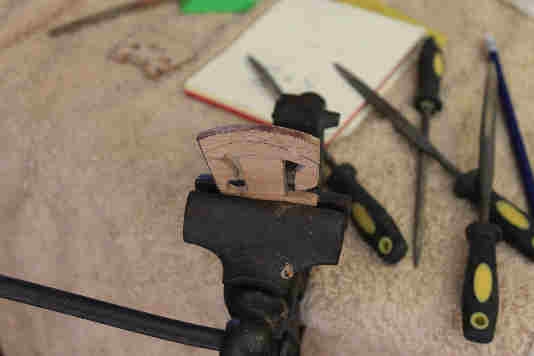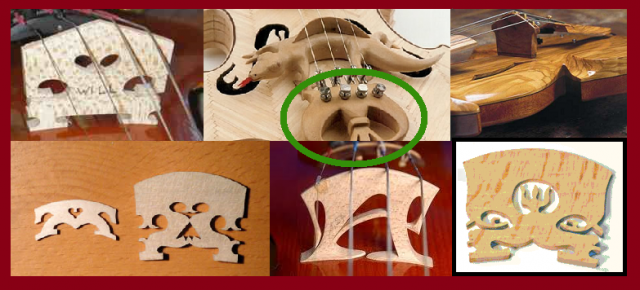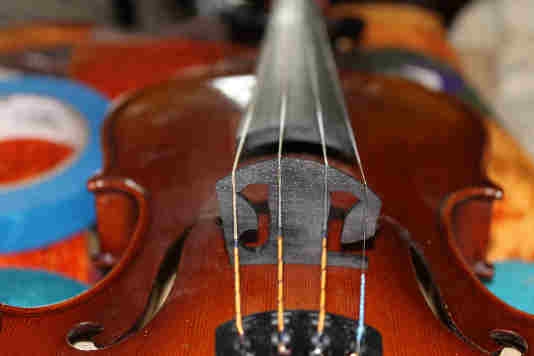Welcome to our forum. A Message To Our New and Prospective Members . Check out our Forum Rules. Lets keep this forum an enjoyable place to visit.
Currently working on errors from the latest (SimplePress) forum update. Many issues have been resoled and others are being worked on. Thank you for your patience.
 Topic RSS
Topic RSS



 (0 votes)
(0 votes) Regulars



Hi Folks
Have been mucking around with bridges again. Mainly because I bored and am in a 'Learning Slump' during which I can't put three notes together without getting one of them wrong. 
After my last bridge post I was thinking about something @Tyberius said in a reply.
I started to think that if I can make a bridge in a wood other than maple and have it work. 'quite well I think' Then why would it have to 'look' like a conventional maple bridge?
That when I came up with the idea of my 'Initial' bridge in Blackwood. Called that be cause the 'holes' in it at 'my' initials, JL. And another departure from the norm is that it has a 'one piece' foot.
It was not meant as a totally 'serious' project but it seems to work. Perhaps with some fine tuning it will be even better ![]() Maybe a hole between the J and L. Or make it 'two' feet.
Maybe a hole between the J and L. Or make it 'two' feet.
The video is a conventional maple vs the 'initial' in blackwood
The violin is my Raggetti. The strings are Larsen Virtuoso. The bow is a Snakewood baroque in both recordings.
Seen it all. Done it all. Can't remember most of ![]() ..... What was I saying????
..... What was I saying???? ![]()











Don't read too much into the image below - but that's a short clip of the open G waveform on both bridges - and really - don't read too much into it considering the round-about trip the sound made to get here!! ( I just like these sort of investigations - they're fun to do ).
Top image is G from the second scaled played, lower image is G from the first scale played.... I think there are two complete cycles highlighted - hang on - I'll do some rough math - the main peaks (more evident on lower trace) are (roughly, come on, that's good enough) 0.005 seconds apart - the frequency is then (roughly) 200Hz. And G3 is 196Hz - so yes - there are two complete cycles highlighted...
As I say, read very little into it - it's just a "curiosity" - sound was captured directly from your video, into Audacity, and just expanded-out to what you see. Nothing particularly scientific about it - but maybe another way of "looking at the results" of your experiments.....
I seriously recommend not copying my mistakes. D'oh -
Please make your own, different mistakes, and help us all learn :-)
Regulars



@BillyG
Bill. Thanks for the graphs. I partly understand what is going on but not fully. Should study up on it.
The experiment is a great departure from the conventional maple bridge being a very different wood, much larger non conventional 'holes', and a one piece foot.
Most luthiers would gasp in horror and shout, "but you can't do that."  But the good thing about not knowing that it can't be done is that sometimes you give it a try.
But the good thing about not knowing that it can't be done is that sometimes you give it a try.
At this point I feel that the maple is better but not by leaps and bounds.With some tuning who know what I'll come out with.
Seen it all. Done it all. Can't remember most of ![]() ..... What was I saying????
..... What was I saying???? ![]()
Regulars
 Offline
Offline


Very interesting results. Nice idea on the frequency response bill.
Ferret, if people didn't experiment with the unknown, the world would still be flat.
The denser the medium, for the most part, the better energy transfer. ( Of course it will also depend on end grain, where stock was cut and stem location) Oak, Ash, Purple Heart and several others are a hard wood. But, what would an aluminum, tin or steel one sound like? I imagine a ringing for the tin and steel and possibly sharp for aluminum. For that matter, one from glass or crystal. I have a 3 day weekend coming up and a nice 2 wheel grinder. One of the wheels is really fine at ~200 grit. Between that and my dremmel, I might try the glass bridge.
I seriously doubt i'll be able to hallow it out, even drilling it in water. I think to cut it from a thick stock then try thinning it after words. I've drilled ceramic, porcelain and glass to fee power cords through, and I do have carbide and industrial diamond bits, but the size of the bridge, I'm thinking, will cause it to crack or at least chip. we'll see. You've sparked my imagination.
I quickly did a web search, here is some of the things I found in the first 2 minutes. Also note the tail piece I circled. ( how can you not want a lizard bridge in that same image) - hahaha. Another area to express yourself in.
"I find your lack of Fiddle, disturbing" - Darth Vader











Yes, although done a "bit off the cuff" so to speak - a more rigorous approach might be interesting.... look at the waveform, also do a spectral analyses - you should see the harmonic peaks. It is gonna be hard to separate out what came from the bowing, the sound box and the bridge - but at least only one thing is changing at a time - the bridge
Suggest: Capture sound and look at waveform and also spectral analyses -
(a) when open strings are plucked, mid-string
(b) when open strings are bowed - trying to get the same pressure and speed (and therefore volume) each time for different bridges
(c) maybe use a pick-up if not already used for more consistent results
(d) Build yourself a robot-mechanism for the bowing tests ! LOL (oh heck - what have I said - I didn't mean your bowing was bad - I just meant for repeatability !)
(e) Build a robot string-plucker....
Bring on the JL bridge !
Great work there JL - I love these practical things ! And @Tyberius - keep us advised on any experiments you do as well !
I seriously recommend not copying my mistakes. D'oh -
Please make your own, different mistakes, and help us all learn :-)
Regulars



Regulars



Have tried something I found in a link that @oliver gave me to do with hardening bridge wood.
The article suggested soaking the bridge in Indian Ink (also called Encre De Chine and Tinta China) as the ink is made of 100% Carbon Black Pigment and is said to harden the wood if the would is soaked in it and allowed to dry.
In another article he sent it was suggested 'toasting' a bridge to harden it So after 'inking' I toasted it under the stove grille at about 150 C untill completely dry.
@BillyG Bill, me ol' mate. ![]() If you would be so kind as to run the resulting video through Audacity and show the graphs I would be greatly appreciated. I'm not really familiar with the program. I think that there has been an improvement though it may only be slight. The vid is the 'initial' bridge as first done and then after the 'inking'
If you would be so kind as to run the resulting video through Audacity and show the graphs I would be greatly appreciated. I'm not really familiar with the program. I think that there has been an improvement though it may only be slight. The vid is the 'initial' bridge as first done and then after the 'inking'
@Tyberius You may be interested in this.
And some feedback from @Barry and @Fiddlerman Would be great As you guys seem to have good ears ![]() Probably better that my 'one' working one
Probably better that my 'one' working one (Truly, only one works properly. The other hardly at all)
(Truly, only one works properly. The other hardly at all)
Seen it all. Done it all. Can't remember most of ![]() ..... What was I saying????
..... What was I saying???? ![]()











Ferret said
@BillyG Bill, me ol' mate.If you would be so kind as to run the resulting video through Audacity and show the graphs I would be greatly appreciated. I'm not really familiar with the program. I think that there has been an improvement though it may only be slight. The vid is the 'initial' bridge as first done and then after the 'inking'
I certainly shall @Ferret
I seriously recommend not copying my mistakes. D'oh -
Please make your own, different mistakes, and help us all learn :-)











Hi Ferret - this may arrive as two separate posts -
First - here are the waveforms - I have given you two sets. The first image is the open G3 with the first bridge (as played time-wise ) in the upper part, and the second-played bridge in the lower part
Check - highlighted sample runs from 33.314 seconds to 33.324 and a bit seconds - that's 10mSec for two complete cycles - 5mSec =~ 200 Hz =~ G3... so far so good dude !
I have also captured your stopped G5 - let's see what that chap looks like.... it is going to be much less "rich" - ( hence my idea as well, of plucking the open strings - but that's another test )
ok - the timescale is expanded out to let us better see it - and I've got 4 complete cycles shown - this is a bit more tricky to verify - but let's try it - start - roughly 33.3240, end 33.3290 - duration 5mSec for four cycles - one cycle =~ 1.25mSec - that's 800Hz - that should be (roughly, roughly) the G3 (196Hz in reality), doubled twice ( 2 octaves up ) - should be 784Hz for G5, we get 800Hz - that's close enough - (or, God forbid, your intonation could be wrong - kidding mate) we're looking at the right thing is all that matters...
I would be interested to see the results of each open string just plucked mid-string... maybe add that on your next trial....
I seriously recommend not copying my mistakes. D'oh -
Please make your own, different mistakes, and help us all learn :-)











And here's the spectral analyses of the stopped G5 -
Top image is first-played bridge
Lower image is second played
The peaks are - in order - G5 - G6 - D7 - G7 - B7 - D8 - F8 - G8 - A8
I suspect the last four may be a bit of a mix of main string overtones with maye a contribution from the resonating after-length - but I'm guessing
I seriously recommend not copying my mistakes. D'oh -
Please make your own, different mistakes, and help us all learn :-)
Regulars



@BillyG
Bill. Thanks for all the info. Impressive I must say.
I'm doing a 'stil run' tonight so I'll give them a good look in the morning. It's a shame I can't send you some of the whiskey. Have been doing it for years and I make a fine product. 
It will be a hard evening, but someone has to do it 
Seen it all. Done it all. Can't remember most of ![]() ..... What was I saying????
..... What was I saying???? ![]()
Regulars
 Offline
Offline


very nice representation.
I have been looking into bridges. The shapes and frequency responses and all manner of technical information I could dig up. I think its going to be like any violin when you do chladni plate testing. You can take 500 bridges cut from the same piece of wood, treat them identically, and have substantial differences in output. With that being said, I still stand behind my guess that if you select a medium able to transfer the energy, you can have incredible results from traditional non-wood bridges. I would guess carbon fibre ( I should patten this) will be not far off.
My glass bridge is not going so well. I have tried 2 so far. 1 flaked off on the back side of the drilled hole and the other cracked on shaping. I was using a pane of tempered glass from a car window for 1 and the second was from the glass of an old CRT monitor. The monitor glass, although slightly contoured, seemed to take the most punishment. The nippers, after scoring it, cut the glass reasonably well, Maybe I was just rushing with impatience, who knows. The powder inside the CRT tastes great heheh (j/k - I used to repair them) I am trying a whiskey bottle next. Its completely flat on the bottom and almost flat on the sides. I just need to empty it first. I am well on my way now  -- any one out there care to assist in draining this bottle with me? .... I mean, its soley for scientific research and all.
-- any one out there care to assist in draining this bottle with me? .... I mean, its soley for scientific research and all. 


"I find your lack of Fiddle, disturbing" - Darth Vader
Regulars



@Tyberius
I hope the next try will be a success. I would love to hear what a glass bridge like.
You have me thinking. During my teens I was interested in Lapidary'. That is shaping stone for jewellery and the like.
The equipment and method work on stone and 'glass'.
'
Seen it all. Done it all. Can't remember most of ![]() ..... What was I saying????
..... What was I saying???? ![]()
Regulars
 Offline
Offline


FM you give people crazy ideas?? HA!! *looks around at all the people who now play the violin* 
The glass bridge again broke. A vibration sets up inside and cause it to chip on the edges. The glass I have been using is just way to thin to grind the way i am doing it. I have a broken pain of old barn glass I am picking up tomorrow and this evening I picked up an old headlight. when I get around to doing it, i'll take pics along the way this time. Maybe someone can see something that might change my process if it fails again.
I though about torching the glass before grinding it, but it might shatter. I do have safety gear, so that is no worries. maybe if I just put in in my mouth and bite down real hard..... I think I need to go investigate with another whiskey bottle. 
"I find your lack of Fiddle, disturbing" - Darth Vader
1 Guest(s)


 Log In
Log In Register
Register























